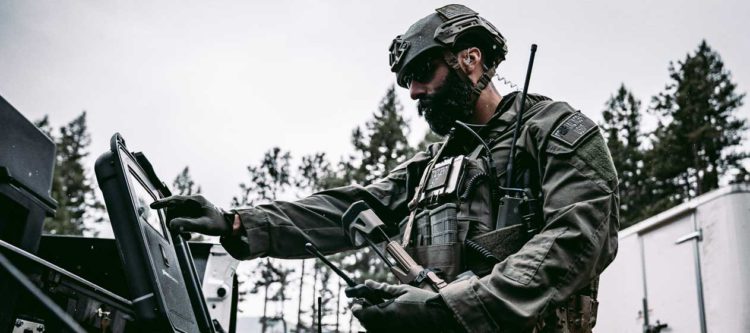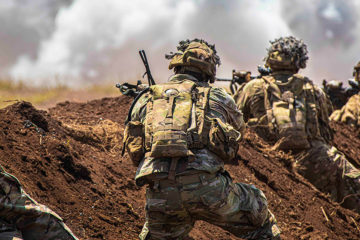Hot Take: Where should goTenna Pro X fall within a PACE Plan?

As part of the Hot Takes series, we’ll be taking a highly debated topic and exploring the pros and cons of both sides. During each debate, you’ll hear from goTenna Pro experts who offer hands-on experience from working with customers and deploying goTenna Pro X devices in the field. Cast your vote, leave a comment below, or sign up for a future debate!
Operators working in remote locations aren’t strangers to having a PACE Communications Plan (Primary, Alternate, Contingency, and Emergency). When a voice radio or cell phone fails on the job, they have to turn to the next available alternative in their comms toolbox.
For example, tactical law enforcement officers could be operating in a scenario requiring radio silence as they are about to implement a drug-busting mission in a cellular dead zone. Their voice comms are no longer an option and their cell services show zero bars. Would goTenna Pro X be the next best thing on their toolbelt?
What about firefighters trying to communicate in the middle of an unpredictable and fast-moving wildfire? Critical infrastructure like radio and cell towers are often early casualties of these destructive fires. Should goTenna Pro X be a backup communications tool in their PACE Plan?
The Last Mile recently asked goTenna team members – Luke Stewart, Mike Gibbs, and Eric Fahnenstiel – to share their take on whether goTenna Pro X should be a primary, alternate, contingent, or an emergency device.
 Luke has hands-on experience as a former firefighter, police dispatcher, and soldier in the U.S Army. In his previous posts on The Last Mile, Luke has covered why firefighters should look to UAVs when it comes to the future of fighting wildland fires and why radios sometimes fall short when battling a wildfire.
Luke has hands-on experience as a former firefighter, police dispatcher, and soldier in the U.S Army. In his previous posts on The Last Mile, Luke has covered why firefighters should look to UAVs when it comes to the future of fighting wildland fires and why radios sometimes fall short when battling a wildfire.
Mike is a U.S. Army (Retired) communications professional with more than twenty-one years of active army federal service and fifteen years of Special Operations Forces experience. He recently authored a post on The Last Mile examining why the ATAK app should be a standard issue for mission readiness training.
Eric has over 10 years of US Army experience and currently serves in 20thSFG(A) as a Special Forces Communications Sergeant. On the civilian side, he works as a Forward Deployed Engineer.
 Luke Stewart, Director of Customer Experience, goTenna
Luke Stewart, Director of Customer Experience, goTenna
I think I’m going to take a more unique stance. I don’t think the goTenna Pro X should belong in a PACE Plan. It should supplement an entire PACE Plan. Ideally, you don’t have to act on the additional steps in your PACE Plan. In a perfect world, everything goes according to plan and your primary communications never fail.
The reason I think the goTenna Pro X shouldn’t fit into a PACE Plan is that if we can ensure the Primary or Alternative forms of communication never fail, you don’t have to worry about the fielded teams having to be able to transition into the next portions of that PACE Plan.
Often in emergency response, there is a personnel accountability report (PAR) required, based on standard operating procedures (SOPs) or the policies that a specific organization has in place. There’s going to be a set time interval where a team leader will call out all of the information required for their team, for their personnel accountability. This way leadership knows everyone’s okay. They’ll know where everyone is and that they have the equipment that they need to continue on a successful mission.
A typical PAR for a fire department is often detailed and lengthy. For example, of course the locations of every member is needed as well as needing to know the amount of air that everyone has remaining during a response if they’re operating tanked up. Or they need to know details about other essential resources, like the amount of water that they have left in reserve in their tanks to go and physically fight a fire. For extended responses, this also includes power levels on response electronics, fuel, medical check-ins, etc.
This report is getting pushed up to every single member of the team who is actually communicating, “This is my location. These are the current conditions. These are my current resources. These are my needs. This is where we are going. This is our route. This is where we’ve been.” all as applicable.
It takes a lot of time over the air, and primary communications can fail simply due to the requirement of PARs on every team in complex responses. The network just gets congested. Too many people are trying to talk, and too many people are trying to listen. As a result, important information is getting lost, delayed, or missed during transmission.
My recommendation would be to use goTenna Pro X to supplement this, so your GPS coordinate information is already being pushed up automatically, behind the scenes. There is no need to reiterate this over the air. That airtime can be saved for something more precious.
Your core tactical situational awareness, and anything related to team composition or formations – especially for tactical law enforcement – is pushed up automatically with goTenna Pro X. And this includes the ability to send text-based messages to supplement anything that would have to otherwise be done over voice. Current and historical locations can simply be seen, and icons/routes can be leveraged to show the plan.
All of this combined creates an environment where there’s less congestion, less noise, and less friction over that network. This, in turn, enables priority traffic to be pushed out, making it ultimately a better environment for that Primary, Alternate, Contingent, or Emergency communication platform to remain operational.
Also, when working with partnering departments and traditional PACE Plans, you have very specific, preset, pre-tuned, expensive equipment to operate. So as you expand into partnering or neighboring agencies – maybe through a joint mission tactical operation for instance – goTenna Pro X provides the capability to push much of the same required data that you would push over Primary, Alternate, and Contingent communications. And this happens by simply scanning a QR code and pushing the power button.
It’s usually cost-prohibitive and adds significantly to deployment gear bulk to buy everyone all of the equipment used in an entire potential area of operations. And the technical understanding required to function on many of the other options for the PACE Plan just doesn’t allow this extension with partnering agencies.
 Mike Gibbs, Senior Forward-Deployed Engineer, goTenna
Mike Gibbs, Senior Forward-Deployed Engineer, goTenna
From a broader sense, PACE Plans change based on who you’re desiring to talk to.
For a small tactical unit, you typically have a PACE Plan for internal and external communications and also an internal PACE Plan for the small unit. From the perspective of a small unit, to the greater world, I would argue that the goTenna Pro X fits into a strong Alternate or Contingent category within the PACE Plan. This can be accomplished when direct line-of-sight can be established as backhaul to the higher unit’s command and control.
Within a small unit the goTenna Pro X jumps to a strong Primary form of communication in the PACE Plan, because it is a reliable means of communication for teams in a localized footprint executing small unit tactics. Utilizing goTenna with another backhaul to a TAK server provides a method of communication that is an even stronger use case.
So, for small units communicating to the outside world, goTenna Pro X should be the Alternate or Contingent form of communication within the PACE Plan. If you’re using it just for small team situational awareness, it should be listed as a strong Primary because it is reliable, provides a line-of-sight, and is highly capable on the ground.
goTenna Pro X also has the capability of enhancing other platforms, as well. Whether we are talking name brand, high throughput MANET radios, goTenna can easily integrate into all of them and enhance their capabilities.
 Eric Fahnenstiel, Associate Forward Deployed Engineer, goTenna
Eric Fahnenstiel, Associate Forward Deployed Engineer, goTenna
To Luke’s point of Net-decongestion, I agree. They also work great for potential use in austere environments; in bug-out bags and cache sites.
I believe goTenna Pro X’s place within the PACE Plan is dependent on the mission. For something like a close quarter battle (CQB) where you think you need voice comms, when you actually start to run using text and data as your Primary communications inside a house, for example, you find it has additional benefits; a team leader can be marking the room (in ATAK) during priorities of work, all while maintaining and updating room status and PLI. But, generally speaking, for a team-internal PACE Plan, goTenna Pro X falls into the Contingent or Emergency categories.
As it stands right now, I wouldn’t include it as a part of any team external PACE Plan, unless you already have goTenna infrastructure in place.
For the tactical law enforcement side, when talking team-internal – which in my opinion would be maybe two other officers in their squad cars – I would put it in that PACE Plan. But to higher, no. I would not put it in any external PACE Plan.
To learn more about PACE Communications Plans, click HERE.







No Comment